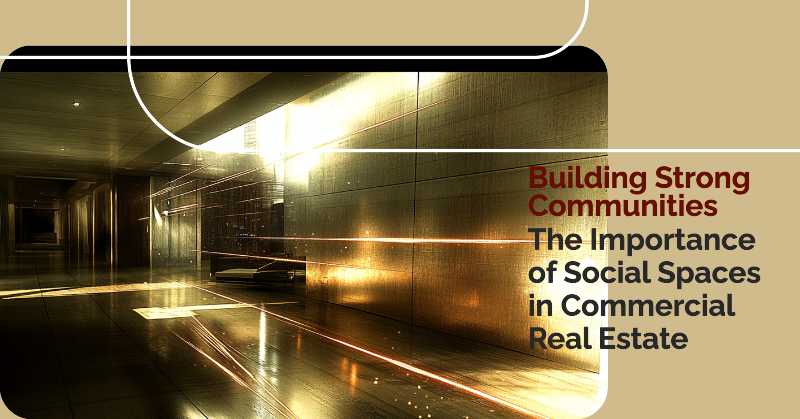
In today’s commercial real estate landscape, community-centric design is becoming a key focus for developers. Modern commercial spaces are no longer just about providing places to work; they are evolving into environments that foster social interaction, collaboration, and a sense of belonging. Shared spaces like lounges, cafes, and outdoor terraces are integral in building vibrant, inclusive communities within these developments.
By creating opportunities for tenants to engage with one another, these spaces enhance the overall tenant experience and build stronger connections within the community. In this edition of Building Tomorrow, we will explore how integrating social spaces in commercial developments can elevate tenant engagement, improve flexibility, and ultimately, drive long-term success for these projects.
The Role of Social Spaces in Fostering Engagement
Incorporating social spaces like lounges, cafes, and rooftop gardens into commercial buildings offers significant benefits in fostering tenant engagement. These shared spaces provide opportunities for informal interactions, helping tenants build relationships that can lead to increased collaboration and a stronger sense of community.
These areas act as hubs for tenants to relax, network, or participate in events, all of which contribute to a more dynamic and engaging environment. The presence of such spaces creates a welcoming atmosphere that encourages tenants to interact beyond their professional roles.
“When thoughtfully designed, social spaces do more than provide comfort—they foster the connections that make a building feel like a community.”
By creating opportunities for organic interactions, social spaces play a critical role in building relationships, making tenants feel more connected to their surroundings and enhancing overall satisfaction with their environment. These communal areas become essential for creating vibrant, collaborative communities within commercial developments.
Transforming ‘Space’ into ‘Place’: The Role of Technology in Shaping Our Environments | Layer 10
Designing for Flexibility: Spaces That Serve Multiple Purposes
Creating flexible communal spaces that can easily adapt to different functions—whether it’s for meetings, social events, or relaxation—adds immense value to commercial buildings. Flexibility ensures that these spaces can be transformed quickly, catering to the varied needs of tenants, from hosting a corporate event to offering a quiet space for relaxation.
By offering multipurpose areas, tenants are empowered to use spaces as they see fit, boosting satisfaction and fostering a sense of belonging.
“Flexibility in design ensures that spaces evolve alongside tenant needs, making them more adaptable, functional, and valuable.”
These versatile spaces ensure that no matter the occasion or requirement, the building can accommodate the dynamic nature of modern work environments, enhancing tenant engagement and creating a vibrant, thriving community.
Blurring Lines with Technology: Creating Integrated Live, Work and Play Spaces | Layer 10
Enhancing Tenant Experience: The Impact of Community Design on Retention
Community-centric design has a profound impact on the tenant experience, directly influencing tenant retention and long-term loyalty. When commercial spaces are designed with shared areas that foster collaboration, relaxation, and social engagement, tenants feel more connected to their environment. This sense of community often results in increased tenant satisfaction, making them more likely to renew leases and remain in the building for the long term.
“Buildings that foster a strong sense of community create loyalty, leading to higher retention rates and long-term success.”
By providing communal areas that enhance the tenant experience, building owners can improve tenant retention, reduce turnover costs, and establish a reputation for creating dynamic, engaging environments. This directly contributes to the long-term success of commercial developments, as satisfied tenants are more likely to stay and advocate for the space.
The Future of Tenant Experience: Beyond Basic Amenities | Layer 10
Conclusion: Building for Connection and Collaboration
Community-centric design offers numerous benefits for commercial real estate developments, from boosting tenant satisfaction to creating vibrant, inclusive environments. By prioritizing the integration of shared social spaces like lounges, rooftop gardens, and multipurpose areas, developers can foster a sense of connection and collaboration among tenants. These spaces enhance tenant engagement, improve retention, and contribute to long-term success. In an increasingly competitive market, property developers who prioritize community-focused design will set their projects apart, creating spaces where people thrive both professionally and socially.
Ready to learn how technology can help create vibrant, community-driven commercial spaces that foster connection and collaboration? Prioritize social spaces and flexible design to enhance tenant satisfaction and drive long-term success. Let Layer 10 help you design innovative, community-centric environments that stand out in the market and meet the evolving needs of tenants.
Contact us today to learn how we can support your next project.
Let’s build tomorrow, today.